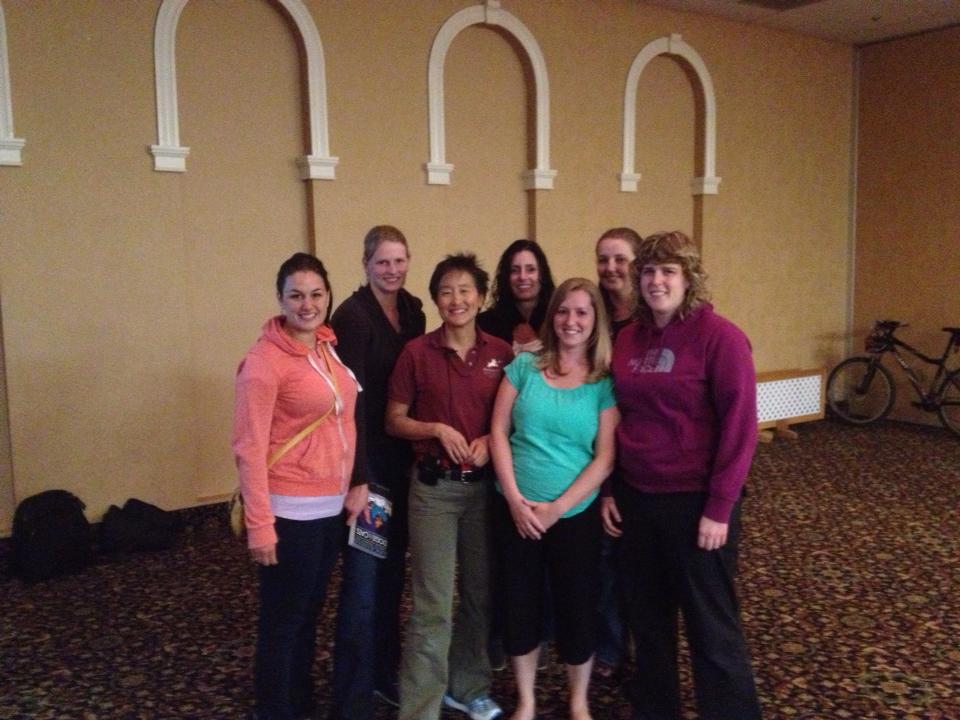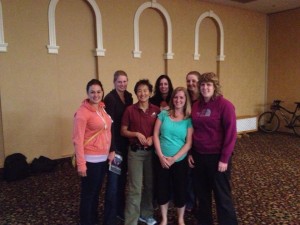
Getting A (Stress-Free) Handle On Your Pets!
Courtesy of: Ashley
One of the wonderful things about working at Truro Veterinary Hospital is the encouragement and opportunity all staff members are given to continuously learn. Recently six of us attended a two day seminar with amazing Animal Behaviourist, Dr. Sophia Yin.
Dr. Yin became a veterinarian in 1993. Soon after, she realized that more and more pets were being brought in to be euthanized due to behaviour problems. In 2001 she graduated with her Masters in Animal Science from UC Davis and focused her studies on Animal Behaviour. Sophia learned that “Every pet needs a human who can lead. Not like a boss, but like a partner in a dance – someone who gives clear signals, rewards desirable behaviour as it occurs, removes rewards for inappropriate behaviour immediately, and sticks to the plan consistently until the new, good behaviour is a habit.” Her knowledge of animal behaviour is widespread and watching her throughout the seminar was like watching Picasso paint…simply put…stunning!
Dr. Yin spoke to a wide range of audience members, including pet owners, day care and kennel workers, groomers, veterinarians and veterinary staff. She spoke at length about the “Earn to Learn Program” where pets (dogs AND cats, among other species) should learn to say “please” by sitting for anything they want. This can be for something like putting on a leash, waiting for you to throw their toy, or sitting for attention. Having your pet sit for attention also reinforces no jumping, and if your puppy learns to do this at a young age, it will become a habit before they are big enough to knock someone over!
Puppies start learning at a very young age when they are still with their mother and littermates. They are like sponges in the sense that they soak up everything – including the bad behaviours we, as pet owners, don’t want. They learn by trial and error – if they do something that works they will continue doing it. Starting to train your puppy as soon as you introduce them into your family will not only start them off on the right paw, but show them what is appropriate and what is not. Introducing your puppy to a wide range of objects and noises will give them more confidence. For more information, visit our blog on socialization! As pet owners, we must realize that every interaction with our pet is a training session. Dr. Yin has published a book called The Perfect Puppy in 7 Days which portrays her own experiences training puppies. She gives a step-by-step guide to start you off. Kaila, our trainer, has also learned many of Dr. Yin’s techniques and will be happy to help you put them into practice.
One of the main reasons I wanted to attend Dr. Yin’s seminar was to learn how to better handle your pets while they are here visiting us. Dr. Yin discussed techniques outlined in her book Low Stress Handling, Restraint and Behaviour Modifications of Dogs and Cats. In this lecture, she gave us pointers to help your pet love their visit or stay at our hospital. She focused on Desensitization & Counter-Conditioning (learning by association) or Operant Counter-Conditioning (learning by trial and error) of pets for things like blood draws, exams and x-rays.
Counter-conditioning is when we put the pet in a new emotional state by pairing food (a pleasant experience) with an experience the pet may be nervous about. This method may not be effective for all pets, however, especially if they are already very stressed about the experience before we get the opportunity to offer them food.
Operant Counter-Conditioning is using positive reinforcement paired with negative punishment. Positive reinforcement means to reinforce (reward) something the pet has done in order to increase the likelihood it will happen again. For example, when your dog sits quietly in her crate, a treat can let her know that you appreciate that behaviour and want to see it again. Negative punishment involves removing the reward the pet is hoping for in order to decrease the chance that the pet will perform that behaviour again. For example, when your dog jumps up for attention, leaving the room and providing no attention will reduce the chance that he will jump up the next time he wants attention.
Dr. Yin demonstrated some towel restraint techniques to use on dogs and cats that can reduce their stress level and that are safer for them and us. However, the steps to helping your pet enjoy a visit to the veterinary hospital really start before they even arrive. I learned some new tips and techniques to counsel owners that they can work on at home, such as getting your cat or dog used to a carrier or a muzzle. Another tip that can make your pet’s visit pleasant is to give them lots of rewards while they are here. That doesn’t necessarily mean treats. Each pet is different in stressful situations so what works at home might not work at the veterinary hospital. If your dog simply enjoys lots of attention, we can reward her by everyone (staff and owners) telling the pet they are a “good boy/girl” and providing plenty of pats and rubs. If your dog likes toys then playing with them in the exam room while you are waiting can ease their stress level. Not feeding your pet before his/her appointment and bringing their meal with you so we can hand it out to them could make it a good experience for them, as they may think “if I’m good I might get more food”. All these tips don’t take extra time at all; just using what “wait time” you have wisely.
Dr. Yin uses “7 general principles of handling difficult dogs”, all of which I believe we do well here, but there is always room for improvement. She reinforced the importance of being part of and providing a comfortable and safe environment, possessing the skills to know how to support each pet, and knowing where to hold and the degree of restraint needed for each individual pet. All pets are individual and the protocol used will vary from pet to pet. Knowing what works and what doesn’t will help us to be successful in making your pet’s next visit more positive.
We were shown the correct way to greet a dog. It is best to approach scared dogs while standing with your back to them and offering treats. Once the pet is calm, sit side-on (don’t bend over them) and let them come to you. Keep your movements slow. She demonstrated that when doing all of these things incorrectly, it can make you look like some alien creature from outer-space with a knife in hand…scary! Videos and photographs were a big part of her seminar, and it reinforced my knowledge on reading body language with cats and dogs.
At the seminar, we got to see firsthand the importance of timing rewards correctly so you capture the correct behaviour. Some people who attended brought their “pets with issues” so Dr. Yin could demonstrate techniques. We learned the difference between the incorrect deliverance time and the correct one. She demonstrated how using the correct deliverance time is crucial when trying to keep the pet’s attention when you are working with them. Keeping your pet focused on you will make training far easier with your pet. She spoke again of “being a partner in a dance”, and indicated that your posture when training can mean one thing when you want another. Being aware of where your hands and arms are, bending at the knees, and your movement speed are all factors that will increase your success when working with your pet.
Dr. Sophia Yin has a wonderful website with lots of information and resources. She has multiple books (I bought two!) and DVDs with LOTS of tips. If you have the opportunity to purchase any of her resources or better yet, see one of her seminars in person, I highly recommend you attend. I left with more knowledge than my brain could store and I will be using her references frequently! If you would like more information, please contact us at 893-2341!
Special thanks to Dr. Gwen Mowbray-Cashen for providing us with this opportunity to learn, to Betty at Stay N Play Canine Centre for organizing Dr. Yin’s seminar in Truro and last, but not least, to Dr. Sophia Yin for opening my eyes further to the world of Animal Behaviour!


0 Comments